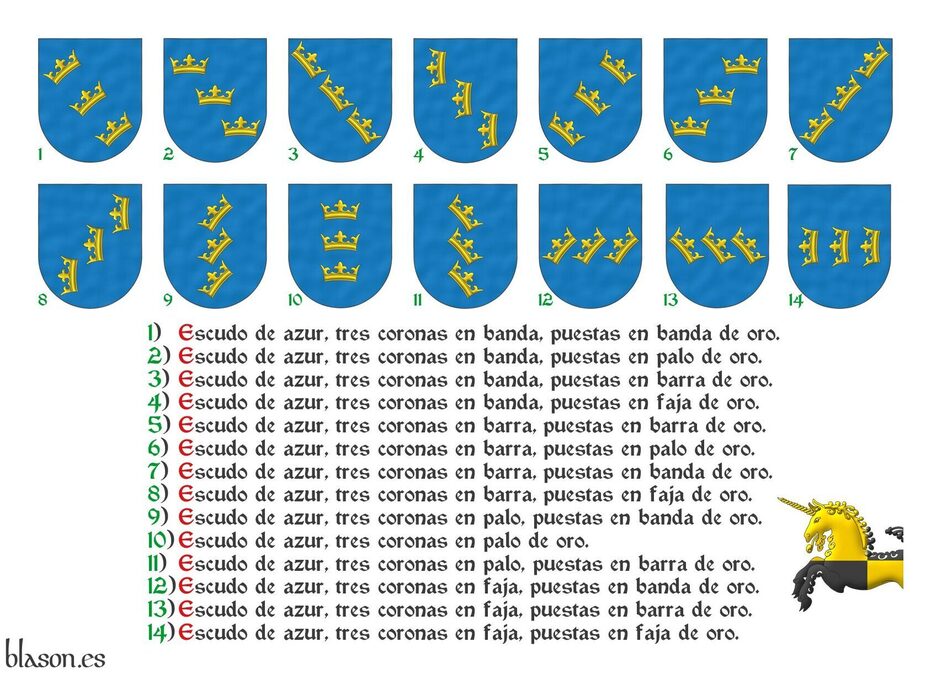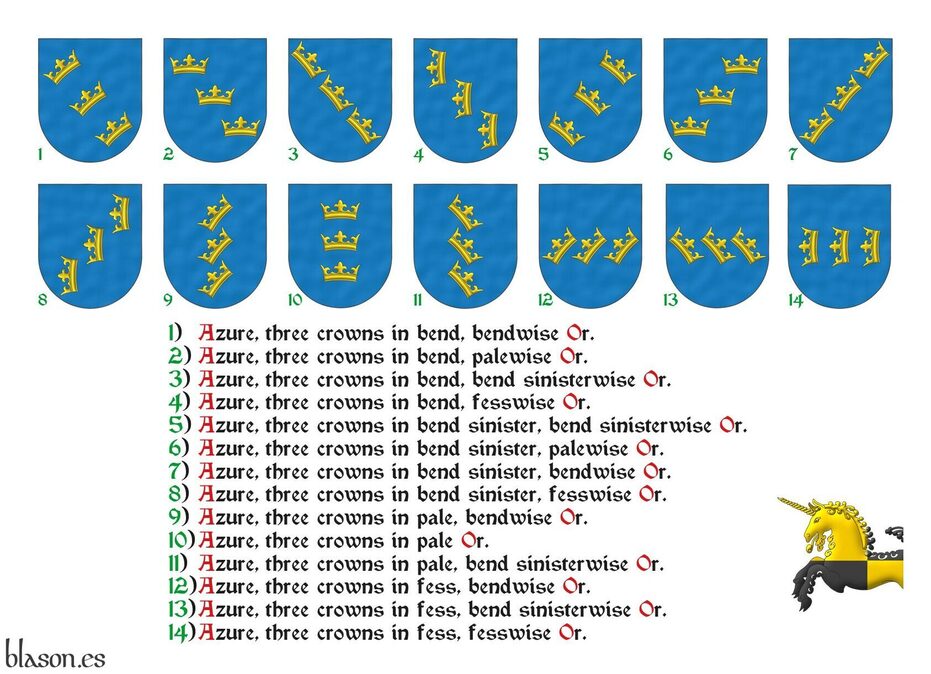
King Arthur, cross flory

Arthur Pendragon
Sinople, a cross flory Argent.
Escudo de sinople, una cruz flordelisada de plata.
Imaginary coat of arms interpreted as follows: the mouth of the shield is triangular and curved; the field has been enameled with flat color Vert; the cross flory is illuminated Argent and shaded; and the finish is crystalline.
Its interpretation has been based on the banner that can be consulted in [Edward IV of England; 1461; row 15, 1st column]. Note that King Arthur is represented in this armorial by 2 different arms.
Blazon keywords: Without divisions, Vert, Argent, Cross flory and Cross couped.
Style keywords: Illuminated, Shaded, Outlined in sable, Crystalline and Triangular curved.
Classification: Interpreted, Imaginary, Coat of arms and Kingdom of England.
Imaginary bearer: Arthur of Britain.


King Arthur, banner with cross flory

Banner Vert, a cross flory Argent.
Pendón de sinople, una cruz flordelisada de plata.
Imaginary banner interpreted in the following way: the banner has a 5x6 proportion; the field has been enameled with flat color Vert; the cross flory is illuminated Argent and outlined in Sable; and the finish is cloth-like.
This banner appears in [Edward IV of England; 1461; row 15, 1st column].
Blazon keywords: Without divisions, Vert, Argent, Cross flory and Cross couped.
Style keywords: Rectangular, Illuminated, Outlined in sable and Fabric.
Classification: Interpreted, Imaginary, Flag, Banner of arms and Kingdom of England.
Imaginary bearer: Arthur of Britain.


![Ver [Scott-Giles, C. W.; 1965] en referencias bibliográficas. Libro abierto, hojas de plata, filo de oro, guardas de gules, tapas de sable.](../css/Libro.Bibliografia.png)
Scott-Giles, C. W.; 1965

Charles Wilfred Scott-Giles, OBE (Officer of the Most Excellent Order of the British Empire), Fitzalan Pursuivant Extraordinary, «Some Arthurian Coats of Arms», Coat of Arms, COA, An Heraldic Quarterly Magazine, issue 64 of October 1965 (which is the date I use as reference) and issue 65 of January 1966, The Heraldry Society, Baldock, Hertfordshire, October 1965.
The coat of arms illustrating this bibliographic reference is one of the variants described in this article attributed to King Arthur, which in Blason.es is cataloged as Arthur of Britain.
Bibliographical reference of century XX.
Author: Scott-Giles, C. W..
Here are the articles quoting this reference:
External link:
Internal resources: ScottGilesCW1965.SomeArthurianCoA.docx.


![Ver [Brutus of Britain] en criterios utilizados. Unicornio saltante sobre la divisa, criterio.](../css/Unicornio.Criterio.png)
Brutus of Britain
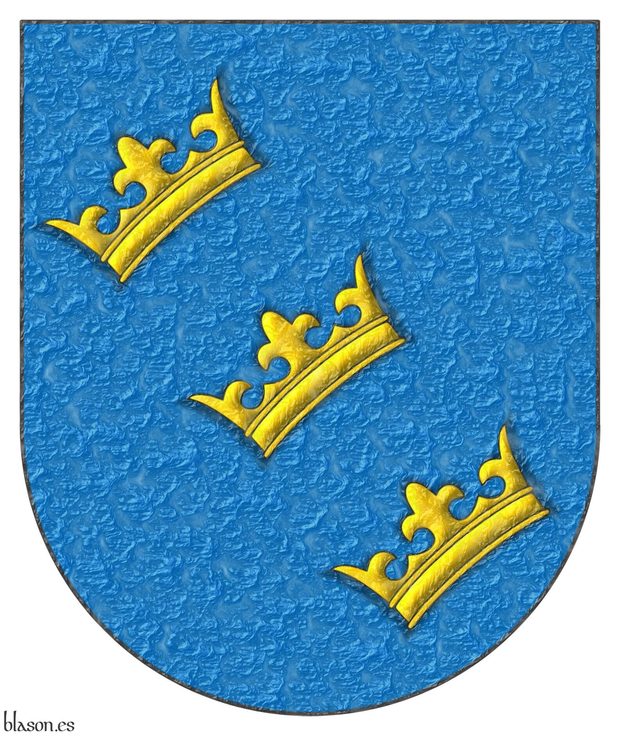
Azure, three crowns in bend, bendwise Or.
Escudo de azur, tres coronas en banda, puestas en banda de oro.
Coat of arms interpreted by me as described below: the field is enameled in plain Azure ink; the three crowns are outlined in Sable, illuminated in Or and shaded; and the imaginary shield has a crystalline finish.
Brutus of Britain, also known as Brutus of Troy, is a mythical character to whom, starting from the 9th century, is attributed the foundation of Britain and even the city of London, which is why this coat of arms is classified as imaginary, because both its holder and, therefore, its coat of arms are imaginary.
The interpretation of this coat of arms was made based on the banner that appears in [Edward IV of England; 1461; row 13, 1st column].
This coat of arms has served as the basis for the realization of the inescutcheon of the banner with the inescutcheon of Edward IV.
Blazon keywords: Without divisions.
Style keywords: Semi-circular, Illuminated, Shaded, Outlined in sable and Crystalline.
Classification: Interpreted, Imaginary, Coat of arms, Kingdom of England and Criterion.
Imaginary bearer: Brutus of Britain.


![Ver [Brutus of Britain, banner] en criterios utilizados. Unicornio saltante sobre la divisa, criterio.](../css/Unicornio.Criterio.png)
Brutus of Britain, banner
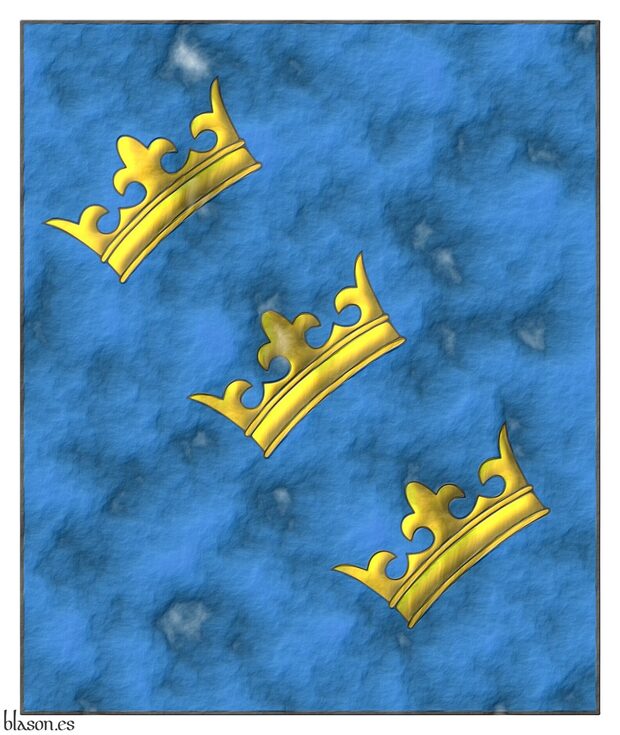
Banner Azure, three crowns in bend, bendwise Or.
Pendón de azur, tres coronas en banda, puestas en banda de oro.
Banner interpreted by me as follows: the field is enameled in plain Azure ink; the three crowns are outlined in Sable and illuminated in Or; and on old parchment.
Banner recreated from [Edward IV of England; 1461; row 13, 1st column].
Blazon keywords: Without divisions.
Style keywords: Rectangular, Illuminated, Outlined in sable and Crystalline.
Classification: Interpreted, Imaginary, Flag, Banner of arms, Kingdom of England and Criterion.
Imaginary bearer: Brutus of Britain.


![Ver [Inescutcheon with the arms of Brutus of Britain] en criterios utilizados. Unicornio saltante sobre la divisa, criterio.](../css/Unicornio.Criterio.png)
Inescutcheon with the arms of Brutus of Britain
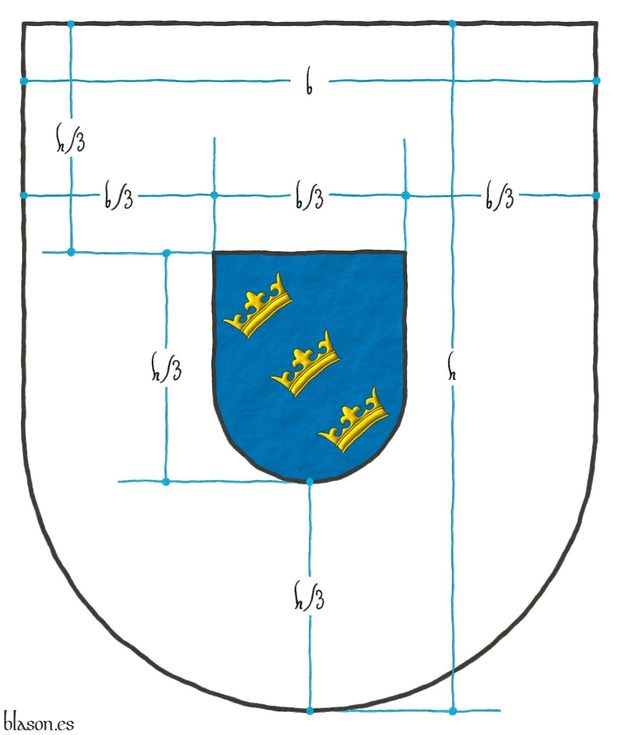
On an inescutcheon Azure, three crowns in bend, bendwise Or.
Escusón de azur, tres coronas en banda, puestas en banda de oro.
Coat of arms interpreted by me as follows: the field is enameled in plain Azure ink; the three crowns are outlined in Sable, illuminated in Or and shaded; and the imaginary shield has a crystalline finish.
Construction process of the inescutcheon of the banner with the inescutcheon of Edward IV from the coat of arms of Brutus of Britain.
Blazon keywords: Inescutcheon.
Style keywords: Illuminated, Semi-circular, Outlined in sable and Watercolor.
Classification: Schema, Interpreted, Imaginary, Kingdom of England and Criterion.
Imaginary bearer: Brutus of Britain.


![Ver [In and wise] en criterios utilizados. Unicornio saltante sobre la divisa, criterio.](../css/Unicornio.Criterio.png)
In and wise
When to specify «en» and when «puesto en» when writing a blazon? In the following articles I try to explain the criterion I follow, and illustrate it with an example, in many of the possible variants.
In Spanish
In English
Classification: Criterion.
Bearer: In and wise.


![Ver [In bend and bendwise] en criterios utilizados. Unicornio saltante sobre la divisa, criterio.](../css/Unicornio.Criterio.png)
In bend and bendwise
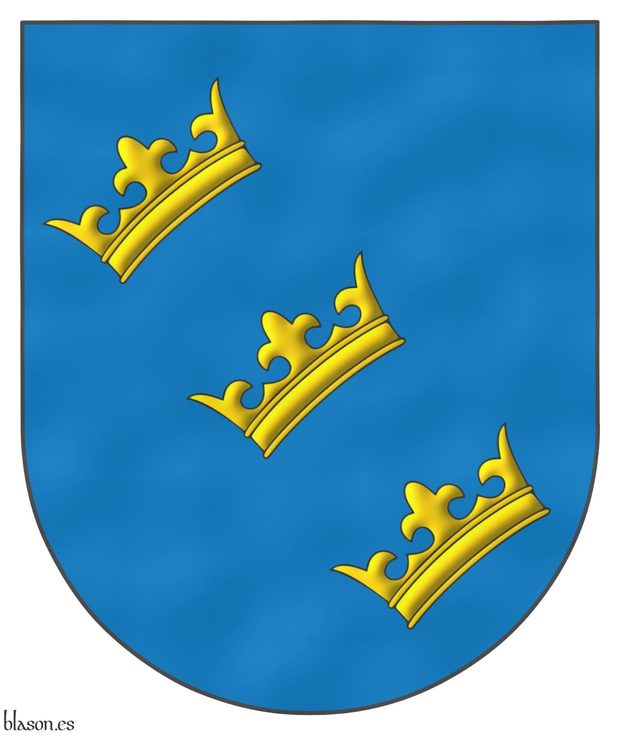
Azure, three crowns in bend, bendwise Or.
Escudo de azur, tres coronas en banda, puestas en banda de oro.
Crown with the main axis being the vertical and central axis of symmetry and which is usually placed palewise. This shield is the imaginary coat of arms of Brutus of Britain, an imaginary character, hero of Troy and founder of Britain.
- En banda ~ in bend.
- Puesto en banda ~ bendwise.
Blazon keywords: Without divisions, Azure, Or, Crown, In bend and Bendwise.
Style keywords: Semi-circular, Outlined in sable and Watercolor.
Classification: Criterion.
Bearer: In and wise.

Continue with: In bend and palewise.
-
Language
-
Categories of heraldry
-
Divisions of the field
- Without divisions
- Party per pale
- Party per fess
- Party per bend
- Party per bend sinister
- Tierce
- Tierce sinister
- Tierced per pale
- Tierced per fess
- Tierced per bend
- Tierced pallwise inverted
- Quarterly
- Quarterly per saltire
- Gyronny
- Party per fess, the chief per pale
- Party per pale, the sinister per fess
- Party per fess, the base per pale
- Party per pale, the dexter per fess
- Chapé
- Chaussé
- Embrassé
- Contre-embrassé
- Party per chevron
- Enté
- Enté en point
- Flanched
-
Metals
-
Colours
-
Furs
-
Other tinctures
-
Ordinaries and sub-ordinaries
-
Diminutives of the ordinaries
-
Other charges
-
Inanimate charges from Nature
Atom, Crescent, Diamond, Emerald, Estoile, Increscent, Lightning flash, Moon, Mount, Mullet, Mullet of four points, Orbital, Plough of Ursa Major, Rainbow, Ray of the sun, River, Sea, Snowflake, Sun, Sun in splendour, Sun of May, Trimount and Water.
-
Vegetal charges from Nature
Acorn, Apple, Apple tree, Ash, Bluebonnet, Camellia, Chrysanthemum, Cinquefoil, Cornflower, Dogwood flower, Double rose, Elm, Fleur de lis, Flower, Holm oak, Hop cone, Kapok tree, Laurel, Lily, Linden, Lotus flower, Madonna lily, Oak, Olive tree, Palm tree, Pomegranate, Poplar leaf, Rose, Shamrock, Sunflower, Thistle, Tree, Tulip, Vine and Wheat.
-
Animal charges from Nature
Badger, Bald eagle, Barbel, Barn owl, Bear, Beaver, Beetle, Bighorn sheep, Blackbird, Boar, Brach hound, Bull, Doe, Dog, Dolphin, Dove, Eagle, Elephant, Falcon, Fish, Flame, Fly, Fox, Frog, Goat, Goldfinch, Goose, Heron, Horse, Hummingbird, Jaguar, Lark, Leopard, Lion, Lion passant, Lion rampant guardant, Lioness, Lynx, Male figure, Martlet, Merino ram, Owl, Panther, Parrot, Peacock, Pelican, Pelican in her piety, Puffin, Quetzal, Raven, Roe deer, Rooster, Savage, Seagull, Serpent, She-wolf, Stag, Starling, Tyger, Vulture, Warren hound and Wolf.
-
Parts of natural charges
Arm, Beak, Branch, Caboshed, Chest, Claw, Covert, Dorsal fin, Eagle claw, Ermine spot, Escallop, Feather, Foot (palmiped), Foreleg, Forepaw, Hand, Head, Heart, Hoof, Leaf, Neck, Ostrich feather, Palm frond, Paw, Roe deers' attires, Shoulder, Sprig, Stags' attires, Stem, Swallow-tail, Tail, Tail addorsed, Tail fin, Talon, Tooth, Trunk, Trunk (elephant), Two hands clasped, Two wings in vol, Udder, Wheat spike, Wing and Wrist.
-
Artificial charges
Ace of spades, Anchor, Anvil, Arch, Arm vambraced, Armillary sphere, Arrow, Axe, Bell, Bell tower, Beret, Bonfire, Book, Bookmark, Bow, Bridge, Broken, Buckle, Cannon, Cannon dismounted, Cannon port, Carbuncle, Castle, Celtic Trinity knot, Chain, Chess rooks, Church, Clarion, Clay pot, Closed book, Club, Comb, Compass rose, Conductor's baton, Cord, Covered cup, Crozier, Crucible, Cuffed, Cup, Cyclamor, Dagger, Double vajra, Drum, Ecclesiastical cap, Fanon, Federschwert, Fleam, Four crescents joined millsailwise, Galician granary, Garb, Gauntlet, Geometric solid, Grenade, Halberd, Hammer, Harp, Host, Hourglass, Key, Key ward, Knight, Knot, Lantern, Letter, Line, Loincloth, Menorah, Millrind, Millstone, Millwheel, Monstrance, Mortar, Mullet of six points pierced, Nail, Non-classic artifact, Norman ship, Number, Oar, Oil lamp, Open book, Page, Pair of scales, Parchment, Pestle, Piano, Plough share, Polish winged hussar, Port, Portcullis, Potent, Quill, Ribbon, Rosette of acanthus leaves, Sabre, Sackbut, Sail, Scroll, Scythe, Sheaf of tobacco, Ship, Skirt, Spear, Spear's head, Stairway, Star of David, Step, Sword, Symbol, Tetrahedron, Torch, Tower, Trident, Trumpet, Turret, Two-handed sword, Wagon-wheel, Water-bouget, Wheel, Winnowing fan and With a turret.
-
Immaterial charges
Angel, Archangel, Basilisk, Dragon, Dragon's head, Garuda, Golden fleece, Griffin, Heart enflamed, Mermaid, Our Lady of Mercy, Ouroboros, Paschal lamb, Pegasus, Phoenix, Sacred Heart of Jesus, Saint George, Sea-griffin, Trinity, Triton, Unicorn, Winged hand and Wyvern.
-
External elements
-
Heraldic creations
-
References
-
Formats
-
Keywords on this page
Watercolor, Arthur of Britain, Azure, Flag, Bibliography, Brutus of Britain, Crown, Crystalline, Criterion, Cross flory, Cross couped, Outlined in sable, In bend, Fabric, Coat of arms, Inescutcheon, Schema, Gules, Illuminated, Imaginary, In and wise, Interpreted, Semi-circular, Ordered, Or, Banner of arms, Argent, Without divisions, Bendwise, Palewise, Rectangular, Kingdom of England, Century XX, Vert, Shaded and Triangular curved.
